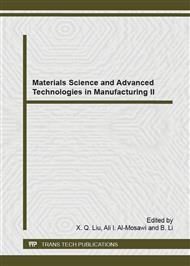[1]
Musun Guo, Hongzhong Li. Manual of fluidization. Beijing: Chemical Industry Press. 2007. 1048-1052.
Google Scholar
[2]
Yongan Wang, Mengtian Bai, Junrong Zhang, et. al. A fluidized bed device to pyrolytic preparation of oxide by salt aqueous solution. CN92224073. 6, (1993).
Google Scholar
[3]
Kawasaki heavy ind. Ltd. Treating waste washing liquor used on iron or steel - to recover iron chloride and hydrochloric acid. JP48094699-A, (1974).
Google Scholar
[4]
Kawasaki steel corp. Oxide material prepn. for ferrite core with improved homogeneity - by spraying mixed aq. chloride soln. into furnace, while spraying zinc and/or copper oxide slurry into zone where soln. is converted to oxide or spinel-type ferrite. JP4369806-A; JP2846149-B2, (1993).
Google Scholar
[5]
Kawasaki steel corp. Method of producing iron oxide as raw material of ferrite - by spraying aqueous ferrous and/or ferric chloride into roasting furnace to give hydrochloric acid and ferrite, using dual liquid nozzle. JP9249420-A, (1997).
Google Scholar
[6]
Kawasaki steel corp. Supply of aqueous iron chloride solution to roasting furnace for producing iron oxide comprises removing solid content in an aqueous iron chloride solution using solid-liquid separator and liquid cyclone. JP 2001026426-A, (2001).
Google Scholar
[7]
Jewell C.J., Marcotte B. Iron Control in Hydrometallurg. Toronto: Ellis Howard Ltd., 1986, 507–519. ( Regeneration of hydrochloric acid waste pickle liquor using a fluidized bed reactor system).
Google Scholar
[8]
Lin Xuanjing. The regeneration process of hydrochloric acid lotion and fluidized bed control . Journal of chemical industry environmental protection, 1990, 3 (10) : 157-163.
Google Scholar
[9]
Yuntao Hong, Liang Qiao, Xinghua Liu. Application of Ruthner-spray hydrochloric acid regeneration technology in cold rolling. The modern chemical industry, 2005, 25(1): 48-50.
Google Scholar
[10]
Guangsheng Zhou, Naiwei Ye. FaultAnalysis and Solution of theW aste Acid Roasting&Regeneration System for Stainless SteelPickling Lines. Baosteel technology, 2005(6): 46-48.
Google Scholar
[11]
Xingming He, Anxi He , Xiuyun Chen, et. Al. Stuydy on the recovery of high purity iron oxide from pickling waste liouor of steel sheet. Steel vanadium and titanium, 2000, 21(4): 18-22.
Google Scholar
[12]
Gu Mingyan, Chen Guang, Liu qing. Determination of control parameters for Producing high quality ferric oxide powder in acid pegenrator. Metallurgical energy, 2003, 22(1): 24-26.
Google Scholar
[13]
Marcus Beck, Viktor Scherer, Siegmar Wirtz. Experiments setup to examine Fe2O3 particle formation in spray roasting reactor. Chem. Eng. Technol. 2005, 28(6): 659-662.
DOI: 10.1002/ceat.200407130
Google Scholar
[14]
Vassilios Zaspalis, Marcel Kolenbrander. Design principles for spray-roasted iron oxides for the manufacturing of ferrites. Powder Technology, 2006, 161: 169-174.
DOI: 10.1016/j.powtec.2005.10.004
Google Scholar
[15]
Marcus Beck, Siegmar Wirtz, Viktor Scherer et al. Numerical calculations of spray roasting reactors of the steel industry with special emphasis on Fe2O3 particle formation. Chem. Eng. Technol. 2007, 30(10): 1347-1354.
DOI: 10.1002/ceat.200700231
Google Scholar
[16]
Frithum. G. Procedure for increasing the specific surface of iron oxides in spray roasting regeneration plants useful as by-product for the production of magnetic material, comprises introducing vapor and air below a burner level of a reactor. PN WO2008070885-A2; WO2008070885-A3, (2008).
Google Scholar
[17]
Magdalena Regel-Rosocka. A review on methods of regeneration of spent pickling solutions from steel processing. Journal of Hazardous Materials, 2010, 177: 57-69.
DOI: 10.1016/j.jhazmat.2009.12.043
Google Scholar
[18]
Ma. X, Zhang. H and Ji. Y. Synthesis of ultrafine lanthanum hydroxide nanorods by a simple hydrothermal process. Mater. Lett, Vol. 58(2004), p.1180.
DOI: 10.1016/j.matlet.2003.08.031
Google Scholar
[19]
Neumann. A, Walter. D. The thermal transformation from lanthanum hydroxide to lanthanum hydroxide oxide. Thermochim. Acta Vol. 445(2006), p.200.
DOI: 10.1016/j.tca.2005.06.013
Google Scholar
[20]
Mekhemer. G, Balboul. B. Thermal genesis course and characterization of lanthanum oxide. Colloids Surf. A , Vol. 181(2001), p.19.
DOI: 10.1016/s0927-7757(00)00731-7
Google Scholar
[21]
Hou. B, Xu Y and Wu D. Synthesis and characteri-zation of ultralong lanthanum hydroxide nanorods via sol-vothermal method. J. Mater. Sci, Vol. 42(2007), p.1397.
DOI: 10.1007/s10853-006-0122-8
Google Scholar
[22]
Wang X, Li Y. Synthesis and characterization of lanthanide hydroxide single crystal nanowires. Angew. Chem. Int. Ed. Vol. 41(2002), p.4790.
DOI: 10.1002/anie.200290049
Google Scholar
[23]
Tang. B, Ge. J and Wu. C. Solvothermal synthesis and microwave evolution of La(OH)3 nanorods to La2O3 nanorods. Nano-technology. Vol. 15(2004), p.1273.
DOI: 10.1088/0957-4484/15/9/027
Google Scholar
[24]
Pan Z, Dai, Z and Wang Z . Lead oxide nanobelts and phase transformation induced by electron beam irradiation. Appl. Phys. Lett. Vol. 80(2002), p.309.
DOI: 10.1063/1.1432749
Google Scholar
[25]
Bouyer F, Sanson N and Destarac M. Hydrophilic block copolymerdirected growth of lanthanum hydroxide nanoparticles. New J. Chem. Vol. 30(2006), p.99.
DOI: 10.1039/b516368d
Google Scholar


